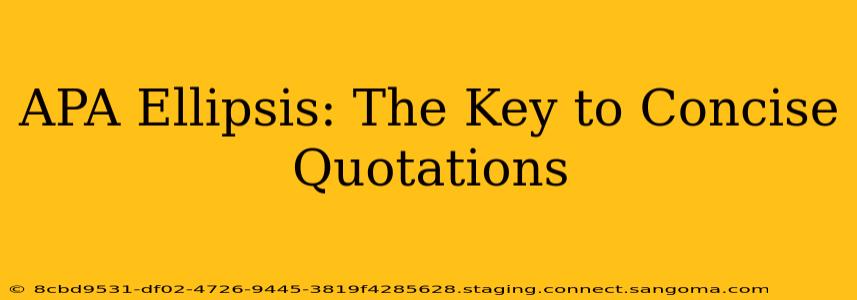Using quotations effectively is crucial for academic writing. However, including entire paragraphs or lengthy passages often disrupts the flow and readability of your work. This is where the ellipsis (...) comes in, a powerful tool in the APA style guide for creating concise and impactful quotations. Mastering the correct use of ellipses within APA style is essential for maintaining both accuracy and clarity in your research papers. This guide will equip you with the knowledge to seamlessly integrate shortened quotations into your writing.
What is an Ellipsis in APA Style?
In APA style, an ellipsis (three periods with spaces between them: . . . ) indicates the omission of words from a direct quotation. It signals to the reader that material has been removed without altering the original meaning or intent of the author's statement. Proper use of the ellipsis ensures the integrity of the original quote while allowing you to present only the most relevant information. Improper use, however, can lead to misrepresentation of the source material.
How to Use Ellipses in APA Style: A Step-by-Step Guide
The key to using ellipses effectively in APA style lies in precision. Here’s a detailed breakdown:
-
Omitting Words Within a Sentence: When removing words from within a sentence, use an ellipsis to indicate the omission.
Example:
Original quote: "The experiment demonstrated a significant increase in productivity, although some unexpected challenges arose during the process. Further research is needed to address these issues."
Shortened quote: "The experiment demonstrated a significant increase in productivity. . . Further research is needed to address these issues."
-
Omitting Words at the Beginning of a Sentence: If you omit material from the beginning of a sentence, you do not need an ellipsis at the start of your quote.
Example:
Original quote: "Furthermore, the results suggest a correlation between the two variables. This finding warrants further investigation."
Shortened quote: "The results suggest a correlation between the two variables. This finding warrants further investigation."
-
Omitting Words at the End of a Sentence: If you omit material from the end of a sentence, use an ellipsis followed by a period to indicate the end of the original sentence.
Example:
Original quote: "The study concluded that the intervention was effective in improving patient outcomes. However, more research is needed to determine the long-term effects."
Shortened quote: "The study concluded that the intervention was effective in improving patient outcomes. . . "
-
Omitting Entire Sentences: When omitting entire sentences, use an ellipsis with a period after each omitted sentence. Note that you should generally only omit sentences if it doesn't change the core meaning of the passage.
Example:
Original quote: "The participants were randomly assigned to one of three groups. The control group received no treatment. The experimental group received the new treatment. The results were statistically significant."
Shortened quote: "The participants were randomly assigned to one of three groups. . . The results were statistically significant."
When Should You Not Use Ellipses?
While ellipses are valuable tools, overuse can make your writing appear choppy or unclear. Avoid using them if:
- The omitted material is crucial to understanding the quote's meaning: Never omit information that changes the author's intended message.
- The quote is already short: If the quote is brief and self-contained, there's no need to shorten it further.
- The omission creates ambiguity: Ensure that the shortened quote remains clear and understandable without the omitted text.
Common Mistakes to Avoid
- Using too many ellipses: Too many ellipses can be distracting and make your writing appear clumsy.
- Omitting crucial information: Remember that the purpose of an ellipsis is to shorten a quote, not to misrepresent it.
- Forgetting the space between periods: Always leave a space between each period in an ellipsis (. . .).
Mastering the APA Ellipsis for Clear and Concise Quotations
By following these guidelines, you can effectively utilize the ellipsis in your APA-style writing. Remember, the goal is to create concise and impactful quotations that support your arguments without sacrificing the integrity of the original source material. Accurate and appropriate use of ellipses will enhance the quality and credibility of your academic work. Using ellipses correctly demonstrates attention to detail and adherence to academic standards.

